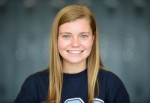Then four-year-old Morghan Golloher had the perfect recipe. One red food coloring bottle and two cups of cornstarch. The gory substance filled the entire plastic bag — to her it was perfect.
After all, it was her own (fake) blood transfusion.
Before kindergarten had rolled around, Golloher was already attempting “blood transfusions” using homemade “blood”, fish tank tubing and a plastic bag. The tubing acted as a filtration device for the blood while the Ziploc was a substitute for the usual blood bank bag. Golloher would do everything from taping toothpicks to a potential IV arm spot to mending her father’s scrapes with neosporin, all while wearing the white doctor jacket her mother, Michelle, had shortened to fit her toddler size.
After her mother saw the fake blood and plastic medical instruments, she was the first to ask the question: “How about medicine?”
Eleven years later, now sophomore Golloher is still following her lifelong dream of wearing that white jacket. With plans to become either a hematologist-oncologist diagnosing blood cancers or a cardiothoracic surgeon inserting a heart valve, she wants to be ready. Prepping now will ensure she can make it through 10 plus years of medical school where some students drop out, according to Golloher.
“If I educate myself with what the medical field entails and what the schooling entails then I will understand how to best go about it,” Golloher said.
As part of her preparation, Golloher is working to build up her volunteer portfolio. Weekends are spent baking rice krispie treats for the Coalition bake sale or leading an alumni tour at East. Through logging these hours, Golloher hopes to gain exposure to all kinds of people. There will be patients in the future wanting to know everything about their upcoming surgery like where the incision will be or how long the recovery period is, and some who couldn’t care less. Luckily, she can rely upon the people skills she’s picked up from racial issue based discussion groups and Coalition fundraisers.
She’s been able to witness the importance of connecting with patients first hand by shadowing a local chiropractor and the first surgical assistant of the trauma unit at Shawnee Mission Medical Center. She’s seen how the physician is able to transform complex medical jargon into a context patients will understand — whether it’s listing off the effects of brain surgery or pointing out the organ just operated on. It’s a technique Golloher hopes to use when she’s talking to patients of her own.
“[The personal interaction] is different than it is with nurses where they’re constantly with the patient but [there’s] that small interaction with [the doctor] where they feel like they’ve found that ‘aha’ moment, like I get what’s going on,” Golloher said.
Over this past summer, Golloher attended the Ambassador Leaders Medical and Health Summit at Johns Hopkins, a medical camp that focuses on finding ways to balance a variety of patient personalities that one might encounter and speak in a manner that’s helpful to the patient. Lectures revolving around the morals of medicine placed an emphasis on how to relate with everyone. Golloher compares it to chess — you have to think several steps ahead and take in everyone’s viewpoints to better understand them.
“I think the most important values are ethics and morals.” Golloher said. “Even though your ethics and morals don’t necessarily align with the patient, you have to think, ‘What’s the best outcome? How am I going to help them to the best of my abilities without letting my own thoughts and beliefs get in the way?’”
Besides shadowing and the summer summit, Golloher has devoted three of her seven classes at East to medical skills – chemistry, biotechnology and EMC. EMC, or Exploring Medical Careers, teaches students how to become a professional in the medical world – from researching medical schools to how to prep for an interview according to Dr. Lee, the EMC teacher. While EMC fuels Golloher’s professional side, chemistry and biotechnology are enhancing her academic side. And with plans to major in either neuroscience and behaviors or biomedical engineering, these classes are necessary.
But without her parents giving her rides to Shawnee Mission Medical Center or paying for her airfare to Baltimore, Golloher wouldn’t be able to extend her medical abilities.
“I tell her she’s capable of whatever her heart desires. I encourage her to try new things and to make sure that she puts her best foot forward,” Michelle Golloher said.
While they’re providing rides, they’re also providing knowledge. Golloher’s father, Kerry, would sit with seventh grade Golloher at the kitchen table, working through a necessary component of medicine — math. Kitchen table calculus lessons may come in handy when she needs to calculate the correct number of white blood cells in the future.
Golloher already has an idea of where she wants to go to school — all 10 plus years of it. There’s 3-4 years at Vanderbilt or Baylor, and an additional 4 years at either Harvard Medical School, the University of Maryland School of Medicine or Perelman School of Medicine followed by a residency. But all that time doesn’t scare Golloher since she considers school to be “a home away from home.”
By the time her schooling ends, hopefully her white jacket will be a perfect fit — no tailoring necessary.
Related



Leave a Reply